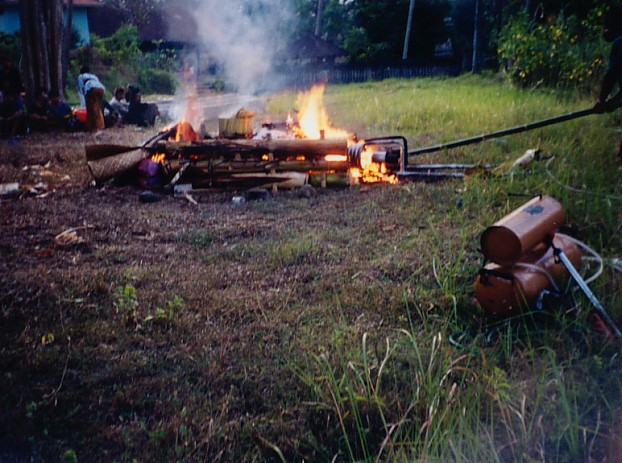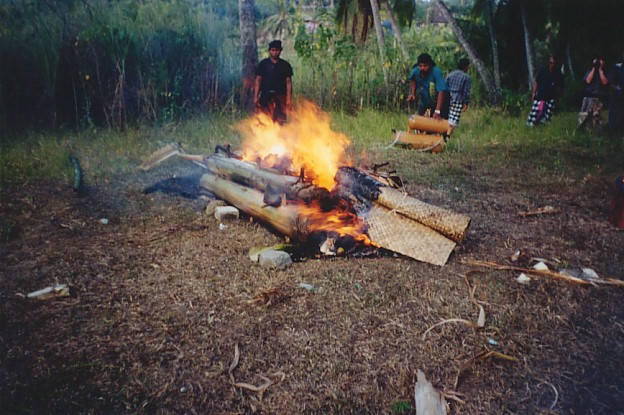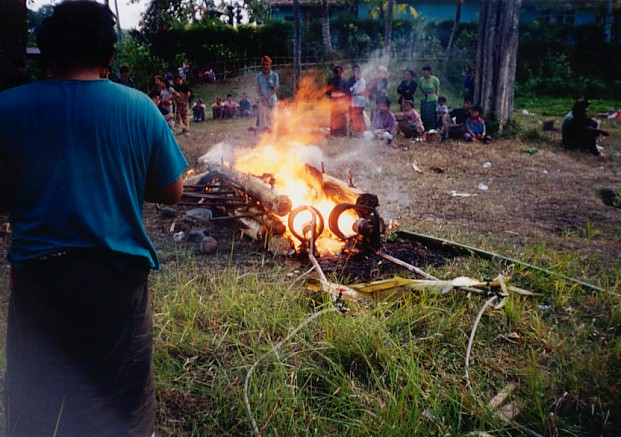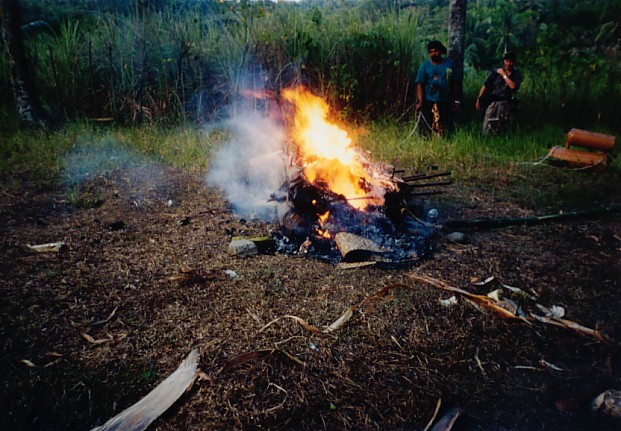Cremation at Tegalingah |
|||||||||||||||||||||||||||||||||||||||||||||||||||||||||||||||||||||||||||||||||||||||||||||||||||||||||||||||||||||||||||||||||||||||||||||||||||||||||||||||||||||||||||||||||||||||||||||||||||||||||||||||||||||||||||||||||||||||||||||||||||||||||||||||||||||||||||||||||||||||||||||||||||||||||||||||||||||||||||||||||||||||||||||||||||||||||||||||||||||||||||||||||||||||||||||||||||||||||||||||||||||||||||||||||||||||||||||||||||||||||||||||||||||||||||||||||||||||||||||||||||||||||||||||||||
|
|
This was a big day for us - we were going to our good friend and teacher Nyoman Sedana's village of Tegalingah to meet his family, and to play on his village's gamelan instruments for a cremation that was happening that day. Then we would go on to Kamasan to meet the gamelan musicians from the village where a piece we play came from. We crammed into our friend Eli's rented minivan (the four of us, Linda and Eli, Justine and Steve, and our Canadian friend Pierre-Olivier) and headed out into the Balinese countryside. Driving in Bali is not to be recommended unless you have a strong constitution and an excellent sense of direction. Balinese drivers are aggressive, to put it mildly, and the roads in Bali are a confusing maze of unmarked (and at night, unlit) narrow lanes with scarcely a signpost anywhere. Added to that, Eli was not used to driving on the left-hand side of the road. After a hair-raising ride we finally made it to Tegalingah - a small village, way off the tourist track and definitely the "real" Bali. We were ushered into Sedana's family compound where we were introduced to his extended family. His grandmother, Swarasanti, is the person that our gamelan back in California is named for. We were then asked to come along to see the cremation that had just started. |
||||||||||||||||||||||||||||||||||||||||||||||||||||||||||||||||||||||||||||||||||||||||||||||||||||||||||||||||||||||||||||||||||||||||||||||||||||||||||||||||||||||||||||||||||||||||||||||||||||||||||||||||||||||||||||||||||||||||||||||||||||||||||||||||||||||||||||||||||||||||||||||||||||||||||||||||||||||||||||||||||||||||||||||||||||||||||||||||||||||||||||||||||||||||||||||||||||||||||||||||||||||||
|
|
 This was markedly different from the cremation we had seen in Peliatan
a week or so before. Apparently this rice-farmer had just died a couple
of days earlier, and since his son owned a store and was quite wealthy
by Balinese standards, he had elected to have the cremation immediately.
But unlike the boisterous cremation in Peliatan this was a somber affair
- the village people stood around in apparent shock, as an industrial-strength
flame-thrower was used to torch the body, which was wrapped in palm mats.
An offering basket woven from palm-leaves sat atop the cremation pyre.
This was markedly different from the cremation we had seen in Peliatan
a week or so before. Apparently this rice-farmer had just died a couple
of days earlier, and since his son owned a store and was quite wealthy
by Balinese standards, he had elected to have the cremation immediately.
But unlike the boisterous cremation in Peliatan this was a somber affair
- the village people stood around in apparent shock, as an industrial-strength
flame-thrower was used to torch the body, which was wrapped in palm mats.
An offering basket woven from palm-leaves sat atop the cremation pyre. |
||||||||||||||||||||||||||||||||||||||||||||||||||||||||||||||||||||||||||||||||||||||||||||||||||||||||||||||||||||||||||||||||||||||||||||||||||||||||||||||||||||||||||||||||||||||||||||||||||||||||||||||||||||||||||||||||||||||||||||||||||||||||||||||||||||||||||||||||||||||||||||||||||||||||||||||||||||||||||||||||||||||||||||||||||||||||||||||||||||||||||||||||||||||||||||||||||||||||||||||||||||||||
|
|
 There was no cremation tower or bulls - this seemed a humble affair, and
the mood was gloomy and sad - the memory of their friend was still fresh
in the villagers' minds. A quiet had descended over the villagers who
looked on. A couple of the men tended the fire and made sure the body
was burning properly.
There was no cremation tower or bulls - this seemed a humble affair, and
the mood was gloomy and sad - the memory of their friend was still fresh
in the villagers' minds. A quiet had descended over the villagers who
looked on. A couple of the men tended the fire and made sure the body
was burning properly.
|
||||||||||||||||||||||||||||||||||||||||||||||||||||||||||||||||||||||||||||||||||||||||||||||||||||||||||||||||||||||||||||||||||||||||||||||||||||||||||||||||||||||||||||||||||||||||||||||||||||||||||||||||||||||||||||||||||||||||||||||||||||||||||||||||||||||||||||||||||||||||||||||||||||||||||||||||||||||||||||||||||||||||||||||||||||||||||||||||||||||||||||||||||||||||||||||||||||||||||||||||||||||||
|
|
 The cremation seemed to be being held on a piece of wasteland next to a
field. A bamboo frame contained the fire which burned intensely. We were
the only Westerners present, but we were made to feel very welcome to be
there.
The cremation seemed to be being held on a piece of wasteland next to a
field. A bamboo frame contained the fire which burned intensely. We were
the only Westerners present, but we were made to feel very welcome to be
there.
|
||||||||||||||||||||||||||||||||||||||||||||||||||||||||||||||||||||||||||||||||||||||||||||||||||||||||||||||||||||||||||||||||||||||||||||||||||||||||||||||||||||||||||||||||||||||||||||||||||||||||||||||||||||||||||||||||||||||||||||||||||||||||||||||||||||||||||||||||||||||||||||||||||||||||||||||||||||||||||||||||||||||||||||||||||||||||||||||||||||||||||||||||||||||||||||||||||||||||||||||||||||||||
|
|

From what we were able to ascertain, a more ceremonial cremation with all the trappings would take place a couple of weeks later. We weren't able to figure out if the body would be burned again, or if a symbolic effigy would be burned in the second cremation. |
||||||||||||||||||||||||||||||||||||||||||||||||||||||||||||||||||||||||||||||||||||||||||||||||||||||||||||||||||||||||||||||||||||||||||||||||||||||||||||||||||||||||||||||||||||||||||||||||||||||||||||||||||||||||||||||||||||||||||||||||||||||||||||||||||||||||||||||||||||||||||||||||||||||||||||||||||||||||||||||||||||||||||||||||||||||||||||||||||||||||||||||||||||||||||||||||||||||||||||||||||||||||
|
|
It seemed that we were not going to play at the cremation itself, but Sedana took us along to the banjar hall and we got out the angklung instruments and began to play there. Only a few kids and a couple of bemused passers-by seemed interested - everyone else in the village was still back at the cremation. Still, it was nice to play, and it was a good warm-up for later. Sedana disappeared on his motorbike to fetch the food, but perhaps because of the cremation, it took a long time before he returned with a delicious "take-out" meal of rice, saté, chicken and vegetables wrapped in banana leaves - quite spicy, but excellent, and well worth the wait. Back at his house, Sedana flicked holy water onto the roof before entering. He explained that this would protect the household from the lower spirits associated with death that might have followed us back to the house. By flicking the holy water onto the roof, everyone under the roof would be protected. Then we piled back into the minivan and Sedana led us on his motorbike to the village of Kamasan. |
||||||||||||||||||||||||||||||||||||||||||||||||||||||||||||||||||||||||||||||||||||||||||||||||||||||||||||||||||||||||||||||||||||||||||||||||||||||||||||||||||||||||||||||||||||||||||||||||||||||||||||||||||||||||||||||||||||||||||||||||||||||||||||||||||||||||||||||||||||||||||||||||||||||||||||||||||||||||||||||||||||||||||||||||||||||||||||||||||||||||||||||||||||||||||||||||||||||||||||||||||||||||
|
|
|
||||||||||||||||||||||||||||||||||||||||||||||||||||||||||||||||||||||||||||||||||||||||||||||||||||||||||||||||||||||||||||||||||||||||||||||||||||||||||||||||||||||||||||||||||||||||||||||||||||||||||||||||||||||||||||||||||||||||||||||||||||||||||||||||||||||||||||||||||||||||||||||||||||||||||||||||||||||||||||||||||||||||||||||||||||||||||||||||||||||||||||||||||||||||||||||||||||||||||||||||||||||||